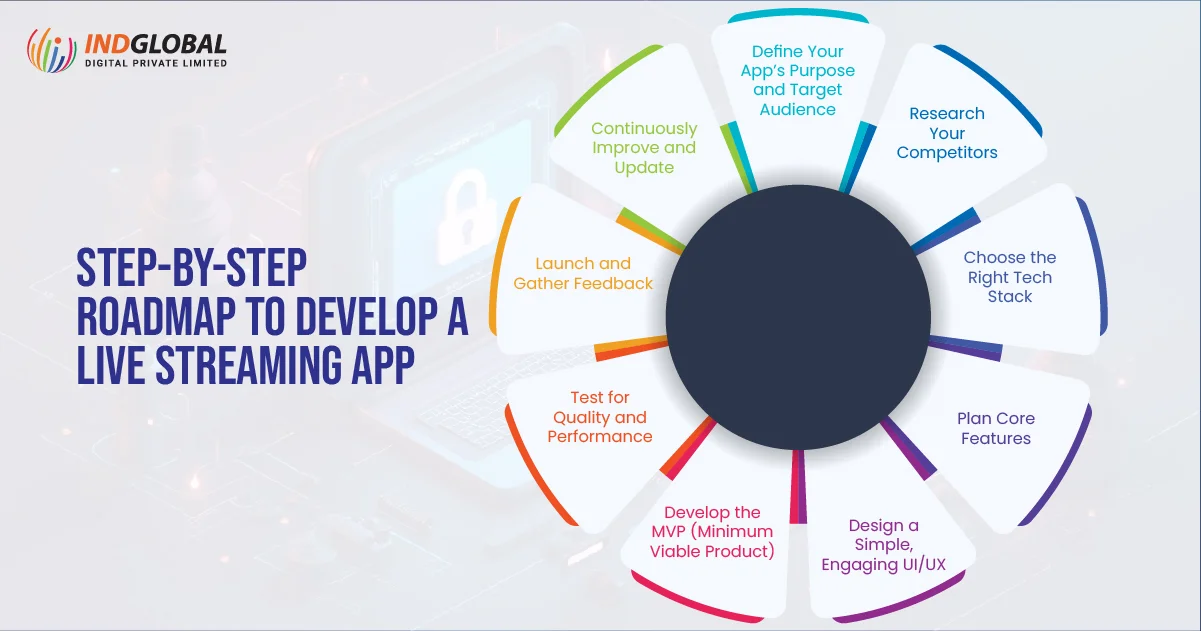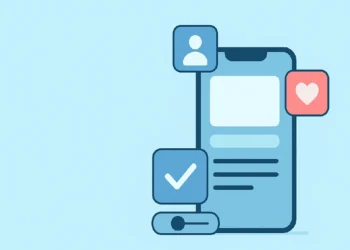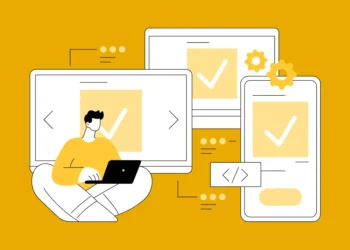The world is growing very quickly, and in recent years, we have witnessed how live streaming is transforming from just a trend into a powerful tool, developing almost every industry from gaming, education, entertainment, and fitness to business. We offer various platforms, including YouTube Live, Twitch, Instagram Live, and more, making it easily accessible to individuals. That’s why more people are engaging with real-time content than ever before. Looking into 2025, the demand for high-quality, interactive, and secure live streaming apps continues to grow.
If you also want to develop your live streaming app, go for it, you’ll not regret it. But it’s not easy; it includes much more than just attaching a video feature. You have to build the right tech stack, a clear understanding of user needs, strong backend infrastructure, and a good monetisation strategy.
Are you ready to explore the complete roadmap for developing a live streaming app? Read it out, no matter if you’re a startup founder, app developer, or tech enthusiast, this guide will help you turn your live streaming idea into a fully functional app.
What is a Live Streaming App?
A live streaming app is a digital platform that allows users to broadcast video content in real-time over the internet. On the other hand, traditional video platforms, where content is pre-recorded and uploaded, live streaming enables instant interaction; viewers can watch, comment, and engage with the content as it happens.
One can use this type of app for various purposes, including online gaming, virtual events, fitness sessions, webinars, product launches, and personal blogs. In India, it’s most famous for online gaming among youth.
Live streaming apps are now used in various industries:

- Entertainment – Live concerts, celebrity interactions, behind-the-scenes sessions.
- Gaming – Platforms like Twitch allow gamers to stream their gameplay live.
- Education – Teachers and tutors conduct virtual classes in real-time.
- Corporate – Businesses host webinars, virtual meetings, and product demonstrations.
- Influencer Marketing – Creators connect directly with followers through Q&As, live product reviews, etc.
Live streaming apps include features like:
- Real-time video broadcasting
- Live chat or comment section
- Viewer engagement tools (likes, emojis, donations, etc.)
- Recording and playback options
- Monetisation models like subscriptions, ads, or tipping
Step-by-Step Roadmap to Develop a Live Streaming App

1. Define Your App’s Purpose and Target Audience
Before starting the development, clearly outline:
- What type of content will be streamed? (e.g., gaming, fitness, education, events)
- Who is your target audience? (e.g., professionals, creators, students)
- What makes your app different from others?
A clear vision helps in designing better features and choosing the right tech stack.
2. Research Your Competitors
Analyse popular live streaming apps like Twitch, YouTube Live, Instagram Live, or Zoom:
- What features do they offer?
- What are their strengths and weaknesses?
- What do users love or complain about in reviews?
This research helps you identify gaps and enhance your app idea.
3. Choose the Right Tech Stack
To support smooth and scalable live streaming, you’ll need to choose:
- Frontend: React Native, Flutter (for cross-platform mobile development)
- Backend: Node.js, Python (Django/Flask)
- Streaming Protocols: RTMP (Real-Time Messaging Protocol), WebRTC, HLS (HTTP Live Streaming)
- Cloud Services: AWS, Google Cloud, or Azure (for storage, media processing, etc.)
- Database: MongoDB, PostgreSQL, Firebase
Choosing the right technologies ensures fast performance and smooth streaming.
4. Plan Core Features
Here are the must-have features for a live streaming app in 2025:
- User Registration/Login (via email, social media, or OTP)
- Live Video Broadcast
- Real-Time Chat/Comments
- Viewer Reactions (Likes, Emojis)
- Monetisation (ads, donations, subscriptions)
- Push Notifications
- Recording & Playback
- Content Moderation (using AI or manual tools)
- User Profile Management
Advanced features can include AR filters, screen sharing, and multi-host streaming.
5. Design a Simple, Engaging UI/UX
A user-friendly interface is key to retaining users. Focus on:
- Easy-to-navigate layout
- Intuitive stream start/stop buttons
- Minimal delay and buffer-free viewing
- Dark/light theme support (for modern feel)
- Accessibility features
Use wireframes and UI mockups to plan before development.
6. Develop the MVP (Minimum Viable Product)
Start by building a basic version of your app with only the essential features. This allows you to:
- Test how the app performs
- Collect user feedback early
- Avoid wasting time and money on unnecessary features
You can continually expand later based on user needs.
7. Test for Quality and Performance
Testing is critical for a live streaming app:
- Functional Testing (Are all features working correctly?)
- Performance Testing (Can the app handle many users at once?)
- Security Testing (Is user data protected?)
- Cross-Platform Testing (Works smoothly on both Android and iOS?)
Tools like JMeter, Postman, and Selenium can help in this phase.
8. Launch and Gather Feedback
Once tested, launch your app on platforms like the Google Play Store and Apple App Store. Promote through:
- Social media
- Influencer partnerships
- Tech communities
- Beta tester programs
Track performance with tools like Firebase Analytics, Mixpanel, or Google Analytics.
9. Continuously Improve and Update
User needs and technology change fast. Keep improving:
- Fix bugs regularly
- Add new features based on feedback
- Update security protocols
- Monitor server performance to avoid crashes
A successful app evolves over time.
Essential Features Every Live Streaming App Needs

1. User Registration & Profile Management
Allow users to sign up quickly using email, phone number, or social media accounts. They should be able to:
- Create and edit profiles
- Upload profile pictures
- View streaming history
- Set privacy preferences
2. Real-Time Live Video Broadcasting
This is the heart of your app. Ensure:
- Seamless, buffer-free streaming
- Multi-device compatibility
- Front and rear camera switching
- Stream scheduling options
3. Live Chat & Viewer Interaction
Engage your audience in real-time with:
- Live chat during broadcasts
- Emojis and reactions
- Polls and Q&A
- Comment pinning and moderation
4. Notifications & Alerts
Keep users updated through:
- Push notifications for upcoming streams
- Alerts for new followers, comments, or donations
- Reminders for scheduled broadcasts
5. Video Recording & Playback
Give users the ability to:
- Record live streams
- Save them in their profiles or cloud
- Offer playback options for those who missed the live session
6. Content Discovery & Search
Make it easy for users to find streams by:
- Category (gaming, fitness, education, etc.)
- Tags or keywords
- Recommended or trending live streams
7. Monetisation Options
Support revenue generation with:
- In-app purchases (virtual gifts, premium features)
- Subscription models
- Ad integration (pre-roll, mid-roll, banners)
- Donations or tipping features
8. Advanced Privacy & Security Controls
Ensure user safety with:
- Stream access control (public/private)
- User blocking/reporting tools
- Two-factor authentication (2FA)
- Content moderation (AI or human-based)
9. Analytics Dashboard
For creators and admins to track:
- Viewer count
- Engagement rate
- Stream duration
- Revenue and performance insights
10. Multi-Device & Cross-Platform Support
Allow users to stream and view from:
- Android & iOS devices
- Web platforms
- Smart TVs or tablets
Conclusion
Live streaming is changing the way we communicate, learn, and entertain, and it’s only getting bigger in 2025. Creating a live streaming app that genuinely stands out involves blending the right technology with features that users love, including smooth video, real-time interaction, easy navigation, and smart monetisation.
But building such an app isn’t a one-person job. That’s where the right team makes all the difference. If you’re serious about bringing your idea to life, working with an experienced mobile app development company in Bangalore can help you get there faster and wiser. The city is home to some of the best mobile app developers in Bangalore who know precisely how to build scalable, user-friendly, and future-ready streaming platforms.
So whether you’re launching your first app or levelling up an existing one, now’s the time to take the leap into live streaming and do it the right way.

















